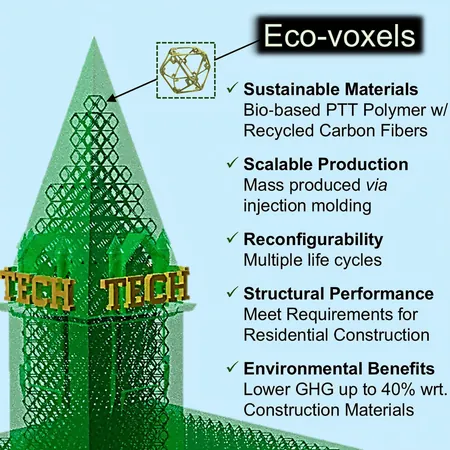
Revolutionary Eco-Voxels: The Future of Sustainable Building on Earth and Beyond!
2025-04-18
Author: Jia
Building a Greener Tomorrow
For centuries, the construction industry has put strength and durability above all else—often at a dire environmental cost. Did you know that construction accounts for about 10% of global greenhouse gas emissions? Shockingly, cement, steel, and concrete contribute to over two-thirds of that total! As the urgency for sustainable solutions skyrockets, researchers are on a quest to transform the very framework of our living spaces.
Introducing Eco-Voxels: A Game Changer in Construction
Enter eco-voxels, a groundbreaking innovation designed by researchers at Georgia Tech. These modular, reconfigurable building blocks could redefine not only how we construct homes but also pave the way for habitats in space! Their recent study published in Matter illustrates that eco-voxels can slash carbon footprints by up to 40% when compared to traditional materials—without compromising necessary structural integrity.
Christos Athanasiou, an assistant professor at the Daniel Guggenheim School of Aerospace Engineering, remarked, "We combined our expertise in structural mechanics and mechanical design with industry practices and environmental assessments to create sustainable structures using these eco-friendly blocks."
Solving the Housing Crisis
With climate-induced disasters on the rise, such as hurricanes and wildfires, homes are increasingly susceptible to damage, leading to skyrocketing insurance costs and a global housing affordability crisis. The eco-voxel system offers a sustainable solution to these mounting issues, as its modularity and circular design can efficiently utilize resources while addressing urgent housing needs.
What Are Eco-Voxels?
Short for eco-friendly voxels—the 3D equivalent of pixels—eco-voxels are crafted from polytrimethylene terephthalate (PTT), a partially bio-based polymer derived from corn sugar. Reinforced with recycled carbon fibers from aerospace manufacturing waste, these building blocks can be effortlessly assembled into robust structures, disassembled, and reconfigured—all without creating waste!
Eco-Voxels vs. Traditional Materials
The research team rigorously tested eco-voxels to ensure they can withstand the stresses of typical buildings. When compared to other innovative construction materials like 3D-printed concrete and cross-laminated timber (CLT), eco-voxels emerged as the clear winner, boasting a carbon footprint that is 30% lower than concrete and 20% lower than CLT!
Fast and Flexible Solutions for Emergency Shelters
These eco-voxels aren’t just a smart choice for permanent homes—they also present incredible potential for emergency shelters! In disaster scenarios, where speed and minimal environmental impact are crucial, structures built with eco-voxels could be rapidly assembled to provide relief for those in need.
Paving the Way for Space Construction
But the innovative uses of eco-voxels don’t stop at our planet. Their lightweight nature and quick assembly make them promising for off-world construction, such as future habitats on Mars or the Moon. Athanasiou emphasizes, "In space, we need lightweight units made from locally sourced materials." Imagine erecting shelters on alien terrains in under an hour!
A Sustainable Future Awaits
As researchers continue to explore how these transformative building blocks can promote environmental health, eco-voxels position themselves as a scalable, low-carbon alternative that could revolutionize construction on Earth and in the cosmos. The future of building is not only about expanding our horizons—it’s also about ensuring the planet thrives.





 Brasil (PT)
Brasil (PT)
 Canada (EN)
Canada (EN)
 Chile (ES)
Chile (ES)
 Česko (CS)
Česko (CS)
 대한민국 (KO)
대한민국 (KO)
 España (ES)
España (ES)
 France (FR)
France (FR)
 Hong Kong (EN)
Hong Kong (EN)
 Italia (IT)
Italia (IT)
 日本 (JA)
日本 (JA)
 Magyarország (HU)
Magyarország (HU)
 Norge (NO)
Norge (NO)
 Polska (PL)
Polska (PL)
 Schweiz (DE)
Schweiz (DE)
 Singapore (EN)
Singapore (EN)
 Sverige (SV)
Sverige (SV)
 Suomi (FI)
Suomi (FI)
 Türkiye (TR)
Türkiye (TR)
 الإمارات العربية المتحدة (AR)
الإمارات العربية المتحدة (AR)